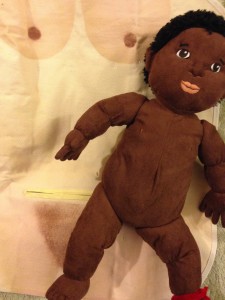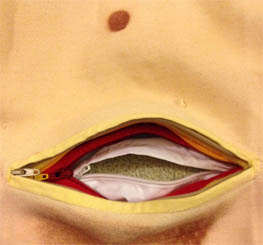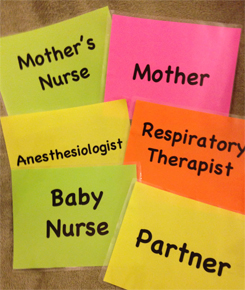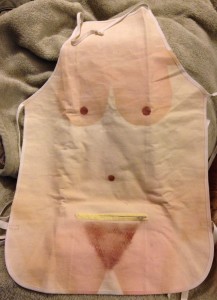April 29, 2015
Series: Brilliant Activities for Birth Educators - Cesarean Section Role Play Helps Prepare Families
By: Sharon Muza, BS, LCCE, FACCE, CD/BDT(DONA), CLE | 0 Comments
 Today, in our monthly series "Brilliant Activities for Birth Educators," I would like to share one of the activities that I do in my Lamaze class to help families feel prepared for a cesarean section. Most families in my classes are planning a vaginal birth, but it never hurts to be prepared should plans change. One in three pregnant people will birth by cesarean in the USA. April is Cesarean Awareness Month and that is why I am sharing this activity at this time.
Today, in our monthly series "Brilliant Activities for Birth Educators," I would like to share one of the activities that I do in my Lamaze class to help families feel prepared for a cesarean section. Most families in my classes are planning a vaginal birth, but it never hurts to be prepared should plans change. One in three pregnant people will birth by cesarean in the USA. April is Cesarean Awareness Month and that is why I am sharing this activity at this time.
Objectives
My objectives for this specific activity are threefold - 1) to share how the procedure is done 2) to offer different options that might be available for the family to request (skin to skin in the OR, delayed newborn procedures, etc., and 3) brainstorm the role of the support person during a cesarean and what kind of support the pregnant person will find comforting and helpful.This role play is done in the fifth week of a seven week series. We have just covered variations in labor (induction, augmentation, EFM, AROM, pain medications, assisted second stage and more). They have heard about the hard and soft reasons for a cesarean and now I hope that they will understand the procedure and the choices and options they might have at the time.
Supplies for the activity and the setup
- Cesarean apron
- surgical masks
- drape
- soft baby
- hair nets
- scrubs
- surgical clothing
- laminated labels for each role
- optional - IV bag, BP cuff, EKG leads, etc
 My main prop in this activity is a "cesarean apron" handmade by Kris Avery, a fellow LCCE here in Washington State. The apron has breasts, a belly button and some pubic hair painted on it, but what makes it special is a series of zippers that correspond to the different layers of a person's body that will be cut during the cesarean procedure. Each zipper is sewn into a different layer and opens to reveal the layer underneath. The skin is represented by the apron, and then there is a layer of fat (yellow felt) that zips open, revealing the uterus (red felt). There are no muscles to "open" because as we know, the abdominal muscles are retracted and not cut. Finally, underneath the uterus, is the amniotic sac, represented by a thin white nylon material.I ask a partner to come with me out of sight of the class and place the cesarean apron on them. All the zippers are closed. I place a soft baby doll (I use the baby from IKEA) underneath the apron with the head positioned right near the inner zipper. Sometimes I place the baby in the breech position and plan on having the bum be removed first. When the partner is ready, we walk together back into the classroom and I ask them to lay on a table, where I have placed a pillow.
My main prop in this activity is a "cesarean apron" handmade by Kris Avery, a fellow LCCE here in Washington State. The apron has breasts, a belly button and some pubic hair painted on it, but what makes it special is a series of zippers that correspond to the different layers of a person's body that will be cut during the cesarean procedure. Each zipper is sewn into a different layer and opens to reveal the layer underneath. The skin is represented by the apron, and then there is a layer of fat (yellow felt) that zips open, revealing the uterus (red felt). There are no muscles to "open" because as we know, the abdominal muscles are retracted and not cut. Finally, underneath the uterus, is the amniotic sac, represented by a thin white nylon material.I ask a partner to come with me out of sight of the class and place the cesarean apron on them. All the zippers are closed. I place a soft baby doll (I use the baby from IKEA) underneath the apron with the head positioned right near the inner zipper. Sometimes I place the baby in the breech position and plan on having the bum be removed first. When the partner is ready, we walk together back into the classroom and I ask them to lay on a table, where I have placed a pillow.
How I conduct the role play
I invite two class members to come up and hold a drape at chest level, just like it might be positioned in the OR. I hand out laminated cards to all the other class members. Each card has the role of someone who might be in the OR during a cesarean section - surgeon, baby nurse, anesthesiologist, surgical tech, respiratory therapist, and so on. I ask the pregnant person who is partnered with my "cesarean person" to play the role of "partner." I invite the partner to get into the white "moon suit" that is normally provided to family members during a cesarean. I hand out hair nets, scrubs, face masks, surgical gowns, to all those who will be in the OR and everyone suits up. I position all the "actors" in the appropriate spot. Some go by a pretend "baby warmer" and others stand around the birthing person while others go where they might be in the real operating room. I talk about how hard it is to tell who is in the room and what their role is, when everyone is wearing scrubs/gowns/hats/masks and suggest that they ask people to introduce themselves. I discuss strategies that the birthing person can use if they are temporarily separated from their support person. I bring the support person over and seat them at the head of the OR table near the "anesthesiologist" and discuss how they cannot see over the drape for both the patient and the partner. The partner can stand up at the time of birth if they wish, or together they could ask for the drape to be dropped at that moment. I ask the pregnant person how they are feeling as the surgery is about to begin. I walk everyone through the procedure step by step and describe what is happening. I share what noises they might hear, and what sensations the pregnant person might "feel." (Tugging, pressure, pulling, but no pain.) I try and give a sense of how long it takes for each part of the operation, (prep, incision to baby, closure) I ask the surgeons to begin to open the zippers, and talk about each layer that they come to. Finally the surgeons are through the amniotic sac and they reach in and remove the baby's head through the opening. It is a somewhat tight fit and we discuss how that might benefit the baby.The baby is delivered, shown to the parents and taken over to the "warmer" where the baby team is waiting. I encourage partner to go over and see the baby, initiate talking to the baby and start sharing information with the birthing person - what the baby looks like, how s/he is doing, and so on.
I walk everyone through the procedure step by step and describe what is happening. I share what noises they might hear, and what sensations the pregnant person might "feel." (Tugging, pressure, pulling, but no pain.) I try and give a sense of how long it takes for each part of the operation, (prep, incision to baby, closure) I ask the surgeons to begin to open the zippers, and talk about each layer that they come to. Finally the surgeons are through the amniotic sac and they reach in and remove the baby's head through the opening. It is a somewhat tight fit and we discuss how that might benefit the baby.The baby is delivered, shown to the parents and taken over to the "warmer" where the baby team is waiting. I encourage partner to go over and see the baby, initiate talking to the baby and start sharing information with the birthing person - what the baby looks like, how s/he is doing, and so on. We go on to discuss how the partner can facilitate having the baby brought over to the birthing person ASAP, skin-to-skin, what might need to happen if baby is moved to the special care nursery, and more. Throughout all of this, the class participants are role-playing through all of the likely activities and people are stepping up to help the family to have a positive experience, within the scope of their assigned role. The surgeons close (zip up) the different layers and close the outer zipper on the skin.I am leaving out much of the detail, as I am confident that you can fill in the activities that happen when a person is prepped, taken to the OR, has the cesarean surgery and is then taken to recover. My hope is to have parents aware of some of the major points of the overall procedure.
We go on to discuss how the partner can facilitate having the baby brought over to the birthing person ASAP, skin-to-skin, what might need to happen if baby is moved to the special care nursery, and more. Throughout all of this, the class participants are role-playing through all of the likely activities and people are stepping up to help the family to have a positive experience, within the scope of their assigned role. The surgeons close (zip up) the different layers and close the outer zipper on the skin.I am leaving out much of the detail, as I am confident that you can fill in the activities that happen when a person is prepped, taken to the OR, has the cesarean surgery and is then taken to recover. My hope is to have parents aware of some of the major points of the overall procedure.
Processing the activity
The class members take off the "costumes" and return to their seats. I feel it is very important to debrief this activity. It can be overwhelming to some. We debrief further, discussing any observations they had, how they felt as our role play was happening. I ask what are the values that are important to them and their family, if a cesarean should be needed. A discussion also takes place about what a cesarean recovery plan might look like and how the family's needs might change if they do not have a vaginal birth.
How is this activity received?
 During the activity, class members are usually very engaged and creative in answering questions, acting out their "roles" and brainstorming solutions to the situations I present. The real magic happens when we debrief. I can see the wheels turning as families articulate what they will want and need should they have a cesarean birth. They learn that they have a voice and can share what is important with their medical team.Time and time again, I receive emails and and notes from class members who ended up having a cesarean. They share how "accurate" our role play was and how it helped them to understand the steps involved with their cesarean. They were able to speak up in regards to their preferences and felt like their class preparation helped to reduce their stress and anxiety.
During the activity, class members are usually very engaged and creative in answering questions, acting out their "roles" and brainstorming solutions to the situations I present. The real magic happens when we debrief. I can see the wheels turning as families articulate what they will want and need should they have a cesarean birth. They learn that they have a voice and can share what is important with their medical team.Time and time again, I receive emails and and notes from class members who ended up having a cesarean. They share how "accurate" our role play was and how it helped them to understand the steps involved with their cesarean. They were able to speak up in regards to their preferences and felt like their class preparation helped to reduce their stress and anxiety.
Summary
This activity takes time and I often wonder if I should replace it with something much shorter that covers the same topic. But, I continue to do this role play activity because I see how it really helps families to understand how to play an active role in the birth of their baby, even if it is by cesarean section.Other resources that I share with the class are the following links:
How might you make a "cesarean apron" that you could use for this activity? Do you have ideas on how you could modify this activity for your classes? What other things do you do to help your families to be prepared for a cesarean birth? I would love to learn how you cover this important topic. Please share your ideas in the comments section below.
Note/Disclaimer: The use of the acronym "BABE" (Brilliant Activities for Birth Educators) is not affiliated with, aligned with or associated with any particular childbirth program or organization.
Tags
Childbirth education Cesarean Pain Relief Cesarean Awareness Month Professional Resources Labor/Birth Brilliant Activities For Birth Educators Natural Birth cesarean BABE Photos